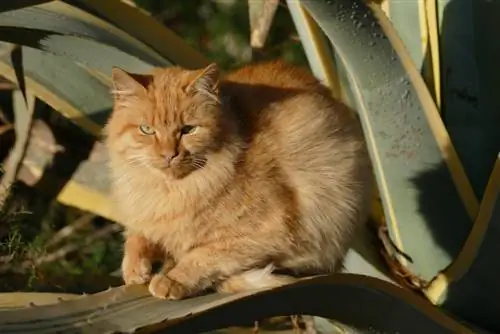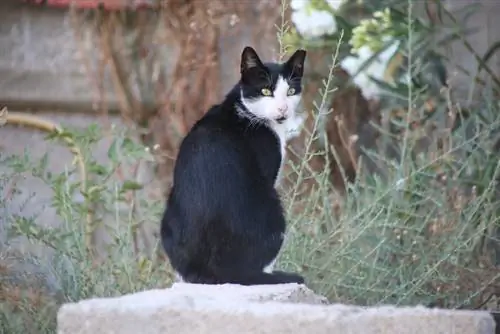- Author admin [email protected].
- Public 2023-12-16 16:46.
- Last modified 2025-06-01 06:02.
Agaves are undemanding houseplants; as true desert plants, they require little water and care. However, the succulents are not suitable for cat owners, as the plant sap in particular is poisonous for the velvet paws.

What symptoms of poisoning does agave cause?
Fortunately, there are no known cases of serious or fatal poisoning from agave in cats. Instead, the sap-containing leaves contain substances that can cause irritation of the mucous membranes and swelling. This in turn leads - depending on the constitution of the cat and the amount consumed - to these typical symptoms:
- Stomach Irritation
- Diarrhea and vomiting
- unsteady, staggering gait
- Muscle tremors and cramps
- frequent drinking
- no or reduced food intake
- listlessness
- Difficulty breathing
Not all symptoms have to occur. If symptoms of poisoning are mild, your cat may only drink more and salivate more, but otherwise behave calmly.
What should you do in case of poisoning?
If you suspect that your cat has poisoned itself after nibbling on an agave plant, you should give it plenty of water - not milk! - offer to drink. Drinking helps to quickly flush out toxins from the body. However, milk should not be offered as it binds the poison in the body due to the fat it contains. Also visit a veterinarian or animal clinic and take a plant sample and/or a vomit sample with you.
How do I keep my cat away from agave?
The easiest way to keep your cat away from poisonous plants is to remove them from your home. If this is not possible or not desired, place the plants out of reach of your four-legged friends - for example in a closed room. You can also distract your cat with non-toxic plants that he can nibble on to his heart's content. For example, cat grass is very popular with animals.
Tip
Some types of agave are edible
Not all types of agave are poisonous. Some, such as blue agave (Agave tequilana), can even be eaten. Due to the high sugar content, the natural sweetener agave syrup is also obtained from them.






